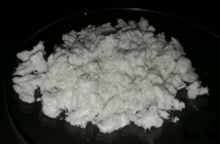ดีดีที

| |||
| |||

| |||
| ชื่อ | |||
|---|---|---|---|
| Preferred IUPAC name
1,1′-(2,2,2-Trichloroethane-1,1-diyl)bis(4-chlorobenzene) | |||
| ชื่ออื่น
Dichlorodiphenyltrichloroethane (DDT)
Clofenotane | |||
| เลขทะเบียน | |||
3D model (JSmol)
|
|||
| ChEBI | |||
| ChEMBL | |||
| เคมสไปเดอร์ | |||
| ECHA InfoCard | 100.000.023 | ||
| KEGG | |||
ผับเคม CID
|
|||
| UNII | |||
CompTox Dashboard (EPA)
|
|||
| |||
| |||
| คุณสมบัติ | |||
| C14H9Cl5 | |||
| มวลโมเลกุล | 354.48 g·mol−1 | ||
| ความหนาแน่น | 0.99 g/cm3 | ||
| จุดหลอมเหลว | 108.5 องศาเซลเซียส (227.3 องศาฟาเรนไฮต์; 381.6 เคลวิน) | ||
| จุดเดือด | 260 องศาเซลเซียส (500 องศาฟาเรนไฮต์; 533 เคลวิน) (สลายตัว) | ||
| 25 μg/L (25 °C)[1] | |||
| เภสัชวิทยา | |||
| QP53AB01 (WHO) QP53AB01 (WHO) | |||
| ความอันตราย | |||
| อาชีวอนามัยและความปลอดภัย (OHS/OSH): | |||
อันตรายหลัก
|
เป็นพิษ เป็นอันตรายต่อสิ่งแวดล้อม สารก่อมะเร็ง | ||
| GHS labelling: | |||
  
| |||
| อันตราย | |||
| H301, H350, H372, H410 | |||
| P201, P202, P260, P264, P270, P273, P281, P301+P310, P308+P313, P314, P321, P330, P391, P405, P501 | |||
| NFPA 704 (fire diamond) | |||
| จุดวาบไฟ | 72–77 องศาเซลเซียส; 162–171 องศาฟาเรนไฮต์; 345–350 เคลวิน[3] | ||
| ปริมาณหรือความเข้มข้น (LD, LC): | |||
LD50 (median dose)
|
113–800 mg/kg (rat, oral)[1] 250 mg/kg (rabbit, oral) 135 mg/kg (mouse, oral) 150 mg/kg (guinea pig, oral)[2] | ||
| NIOSH (US health exposure limits):[4] | |||
PEL (Permissible)
|
TWA 1 mg/m3 [skin] | ||
REL (Recommended)
|
Ca TWA 0.5 mg/m3 | ||
IDLH (Immediate danger)
|
500 mg/m3 | ||
หากมิได้ระบุเป็นอื่น ข้อมูลข้างต้นนี้คือข้อมูลสาร ณ ภาวะมาตรฐานที่ 25 °C, 100 kPa
| |||
ดีดีที (DDT) ย่อมาจาก ไดคลอโรไดฟีนิลไตรคลอโรอีเทน (อังกฤษ: dichlorodiphenyltrichloroethane) เป็นยาฆ่าแมลงประเภทสารสังเคราะห์ออร์กาโนคลอรีน นิยมใช้มาตั้งแต่ช่วงสงครามโลกครั้งที่สอง
ดีดีทีถูกสังเคราะห์ขึ้นเป็นครั้งแรกตั้งแต่ปี ค.ศ. 1874 โดยออตมาร์ ซีดเลอร์ นักเคมีชาวออสเตรีย [5] แต่นักวิทยาศาสตร์เพิ่งทราบคุณสมบัติในการกำจัดแมลง ในปี ค.ศ. 1939 จากการค้นพบโดยพอล แฮร์มันน์ มูลเลอร์ นักเคมีชาวสวิส จากนั้นดีดีทีได้ถูกนำมาใช้ในการควบคุมโรคมาลาเรียและไข้รากสาดใหญ่ ในช่วงสงครามโลกครั้งที่สอง และนิยมใช้กำจัดแมลงศัตรูพืชและผลผลิตทางเกษตรกรรมในช่วงหลังสงคราม ประมาณการว่ามีการผลิตและใช้งานดีดีทีถึง 1.8 ล้านตัน [1]
ในปี ค.ศ. 1962 นักชีววิทยาชาวอเมริกันชื่อ ราเชล คาร์สัน ได้ตีพิมพ์หนังสือชื่อ Silent Spring บรรยายถึงผลกระทบของดีดีทีต่อสิ่งแวดล้อม, การก่อให้เกิดมะเร็งในมนุษย์ และทำให้สัตว์ป่าหลายชนิดโดยเฉพาะนกเช่น อินทรีหัวขาว มีจำนวนลดลงจนเสี่ยงต่อการสูญพันธุ์ [6] ทำให้เกิดการศึกษาวิจัยสืบเนื่อง และรณรงค์ให้ยกเลิกการใช้ดีดีทีอย่างขนานใหญ่ในสหรัฐอเมริกา จนมีการประกาศใช้กฎหมายห้ามใช้ดีดีทีในสหรัฐอเมริกา ตั้งแต่ปี ค.ศ. 1972 และเกิดอนุสัญญาสต็อกโฮล์ม ห้ามการใช้ดีดีทีทั่วโลกมาตั้งแต่ปี ค.ศ. 2001 [7]
อ้างอิง[แก้]
- ↑ 1.0 1.1 1.2 Toxicological Profile: for DDT, DDE, and DDE. Agency for Toxic Substances and Disease Registry, September 2002.
- ↑ "DDT". Immediately Dangerous to Life and Health Concentrations (IDLH). National Institute for Occupational Safety and Health (NIOSH).
- ↑ NIOSH Pocket Guide to Chemical Hazards. "#0174". National Institute for Occupational Safety and Health (NIOSH).
- ↑ "NIOSH Pocket Guide to Chemical Hazards".
- ↑ Environmental Health Criteria 9: DDT and its derivatives, World Health Organization, 1979.
- ↑ "Bald Eagle Facts and Information". American eagle foundation. คลังข้อมูลเก่าเก็บจากแหล่งเดิมเมื่อ 2007-12-06. สืบค้นเมื่อ 2008-01-03.
- ↑ Stockholm Convention on Persistent Organic Pollutants
อ่านเพิ่มเติม[แก้]
- Berry-Cabán, Cristóbal S. "DDT and silent spring: fifty years after". Journal of Military and Veterans' Health 19 (2011): 19–24. online
- Conis, Elena. "Debating the health effects of DDT: Thomas Jukes, Charles Wurster, and the fate of an environmental pollutant". Public Health Reports 125.2 (2010): 337–342. online
- Davis, Frederick Rowe. "Pesticides and the perils of synecdoche in the history of science and environmental history". History of Science 57.4 (2019): 469–492.
- "DDT Banning" in Richard L. Wilson, ed. Historical Encyclopedia of American Business, Vol I. Accounting Industry – Google, (Salem Press: 2009) p. 223 ISBN 978-1587655180. OCLC 430057855
- Dunlap, Thomas, ed. DDT, Silent Spring, and the Rise of Environmentalism (University of Washington Press, 2008). OCLC 277748763
- Dunlap, Thomas, ed. DDT, Silent Spring, and the Rise of Environmentalism: Classic texts (University of Washington Press, 2015). ISBN 978-0295998947. OCLC 921868876
- Jarman Walter M., Ballschmiter Karlheinz (2012). "From coal to DDT: the history of the development of the pesticide DDT from synthetic dyes till Silent Spring". Endeavour. 36 (4): 131–142. doi:10.1016/j.endeavour.2012.10.003. PMID 23177325.
- Kinkela, David. DDT and the American Century: Global Health, Environmental Politics, and the Pesticide That Changed the World (University of North Carolina Press, 2011). ISBN 978-0807835098. OCLC 934360239
- Morris, Peter J. T. (2019). "Chapter 9: A Tale of Two Nations: DDT in the United States and the United Kingdom". Hazardous Chemicals: Agents of Risk and Change, 1800–2000. Environment in History: International Perspectives 17. Berghahn Books. 294–327. doi:10.2307/j.ctv1850hst.15 (book: doi:10.2307/j.ctv1850hst; JSTOR j.ctv1850hst).
แหล่งข้อมูลอื่น[แก้]
- Chemistry
- DDT at The Periodic Table of Videos (University of Nottingham)
- Toxicity
- "DDT Technical Fact Sheet" (PDF). National Pesticide Information Center. เก็บ (PDF)จากแหล่งเดิมเมื่อ 2003-06-29.
- "DDT General Fact Sheet" (PDF). National Pesticide Information Center. เก็บ (PDF)จากแหล่งเดิมเมื่อ 2003-03-22.
- Scorecard: The Pollution Information Site – DDT
- Interview with Barbara Cohn, PhD about DDT and breast cancer
- Pesticide residues in food 2000 : DDT
- Politics and DDT
- Swartz, Aaron (September–October 2007). "Rachel Carson, Mass Murderer?: The creation of an anti-environmental myth". Extra!.
- Tierney, John (June 5, 2007). "Fateful Voice of a Generation Still Drowns Out Real Science". The New York Times.
- Malaria and DDT
- Berenbaum M (4 June 2005). "If Malaria's the Problem, DDT's Not the Only Answer". Washington Post.
- 'Andrew Spielman, Harvard School of Public Health, discusses environmentally friendly control of Malaria and uses of DDT Freeview video provided by the Vega Science Trust
- "Ugandan farmers push for DDT ban". ABC News. Australian Broadcasting Commission. 31 May 2008.
- DDT in popular culture
- Dunning, Brian (November 2, 2010). "Skeptoid #230: DDT: Secret Life of a Pesticide". Skeptoid.
- Phil Allegretti Pesticide Collection consisting of ephemera and 3-D objects, including cans, sprayers, and diffusers, related to DDT pesticide and insecticide in the United States in the mid-20th century (all images freely available for download in variety of formats from Science History Institute Digital Collections at digital.sciencehistory.org).



